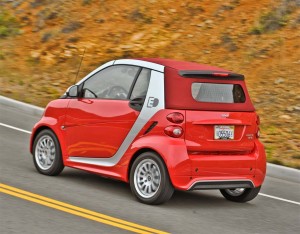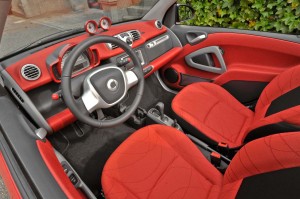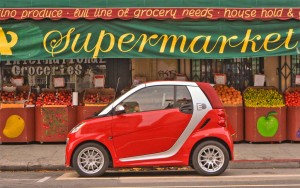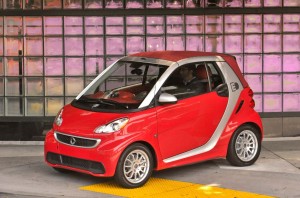It’s become one of the more familiar silhouettes on the road – not necessarily a good thing considering the Smart fortwo has been around in Europe since before the turn of the Millennium and in U.S. showrooms since 2007. That said, the maker is rolling out an all-new version worth another look: the Smart Fortwo Electric Drive – or, if you prefer for a car this small, let’s just call it the ED.
This is the third-generation battery car for Daimler AG’s microcar brand and the most ambitious, which is probably understandable considering it is also the most functional and enjoyable version of the ED yet. The 2013 Smart battery car is faster, delivers better rage and steers and handles better than its predecessors.
But what could be the most effective selling point for the third-generation Smart Fortwo ED is the price tag. The maker launched the 2013 model at $199 a month. That included a $119 charge for the car itself and another $80 a month for the new Battery Assurance Plan. In other words, customers lease the battery separately from the car itself. Oddly, the package actually came in at half the earlier lease price for the entire vehicle, battery included. But to make the Fortwo ED even more appealing, Smart is now dropping the package price for the Coupe to just $139 a month.

The 2013 Smart ED is available as both a coupe and as a cabriolet - the only convertible battery car, in fact.
As for the cabriolet – and, yes, Smart is the only maker to offer a convertible electric vehicle – that now drops from $239 to $199 a month.
(For more on the new Battery Assurance Plan and other Smart news, Click Here.)
Smart is just the latest maker to drop prices hoping to boost battery car sales which have been lagging far behind proponents’ expectations. But price alone likely won’t do much to move the needle if the vehicles don’t deliver better features, range and performance. To see how the Fortwo ED delivered, TheDetroitBureau.com headed to Ann Arbor, Michigan for some driving time.
First, the basics: the third-generation Smart Electric Drive is powered by 47-horsepower electric motor which can muscle up to 74 hp if you push it into what might be called electric supercharger mode. That’s up from 27 hp (and 40 peak) with the previous generation. The new motor also deliver 96 foot pounds of torque, which makes itself felt promptly while keeping up with traffic or merging onto a freeway, where the older EV struggled a bit.
A peak 74 hp might not sound like much but considering the miniscule size of the Smart fortwo that’s enough to launch from 0 to 60 mph in just 11.5 seconds, according to the maker. That’s a full 1.2 seconds faster than the gasoline-powered Smart Fortwo and it compares with an anemic 26 seconds for the Gen-2 ED. Top speed, meanwhile is now 78 mph, compared with the old 62 miles per hour – which wasn’t exactly encouraging if you needed to get on the highway.
The all-new smart electric drive is rated at 122 city MPGe, or miles per gallon gasoline-equivalent, according to the EPA. This is a somewhat mysterious number that is designed to give a buyer a sense of how efficient the vehicle is compared to a conventionally-power automobile.
However, the number that is more likely to matter to buyers is 76 – as in 76 miles per charge. And here, Smart was only able to squeeze out a single extra mile compared to the previous ED, which has to be considered something of a disappointment.
Range depends, of course, on how aggressively you drive, where you drive and weather and road conditions. The combined city/highway range is a bit better, and you’ll pick up some extra miles if you minimize jack rabbit starts and effectively use brake regeneration.
(In fact, even the regen braking system is far smoother and quieter than the system used in the 2011 smart EV. The improvements in the brake system enhance the quiet environment that is the one key features and attractions of driving an EV.)
(Chevy slashes $5,000 off Volt plug-in price.Click Here for the story.)
Daimler representatives tried to finesse the range issue by noting most users will recharge on a regular basis once the battery reaches 20% just as they do with a cell phone.

The Fortwo cabin is largely the same - but for special gauges that show, among other things, remaining battery charge.
Charging time depends on a variety of factors, including battery temperature. From a 240-volt outlet, it only takes 3½ hours to go from 20 to 80%, and about six hours to reach full charge from a depleted battery. You’ll roughly double those numbers with a standard 120-volt outlet.
Another disappointment was Smart’s decision not to offer a high-speed 440-volt DC quick charger outlet, which could get you to 80% from a drained battery in just 20 minutes or less. “It’s something we’re keeping in mind” for a future update when there are more available so-called Level 3 chargers, Mike Martin, the program manager, told TheDetroitBureau.com.
On the plus side, the Smart ED doesn’t suffer from the insufferable manumatic gearbox found in the gasoline version of the Fortwo – perhaps the single biggest factor working against that microcar.
As we mentioned, the Smart ED is available in coupe and cabriolet body styles, both maintaining what has been the smallest footprint of any car on U.S. roads. The electric drive battery fits right where the fuel tank usually goes, in the underfloor area between the front and rear wheels normally housing the gas tank. That position actually lowers the vehicle’s center of gravity and modestly improves its cornering capabilities.
The extremely short wheelbase makes the Smart Fortwo quite nimble, particularly in urban, low-speed driving. On fast roads it’s a fair bit more twitchy and susceptible to jouncing around on Michigan’s ruined roads.
But the overall shift in weight distribution, along with the added power, make the Smart Fortwo ED more stable and easier to handle and, I thought, more fun to drive.
Electric vehicles, in general, aren’t for everyone. And the Smart Fortwo, even with a gas motor, is not for the mainstream. Curiously, when you combine an electric motor and the Fortwo you get what is an arguably better package. Now factor in the minimal price tag and you just might find reason to give the Smart Fortwo ED a test drive.
Paul A. Eisenstein contributed to this report.



Some of these low powered vehicles are a real danger for anything but city driving. I’ve seen the not so Smart cars in Germany cause massive traffic back-ups on rural roads (62 mph) because they could not or world not drive at reasonable speeds.
I also notice a Prius the other day had a tough time getting up to the 70 mph highway speed on a modest length entry ramp. With four lanes of traffic moving at 60-70 mph it created some near misses.
As far as the costs of EVs including operating costs, people will be shocked to see their electric bills unless they live next to the TVA. With all of the drawbacks to EVs it’s a real stretch but auto makers have no choice but to try and convince people to buy these as the fines for failing to meet the absurd 54.5 mpg CAFE requirements are significant.